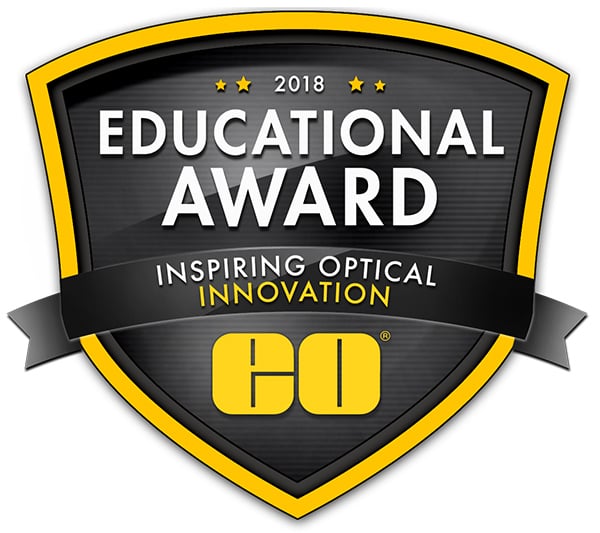

Norman Edmund Inspiration Award Winner
University of Waterloo, Canada — Submitted by Zohreh Hosseinaee
Ms. Hosseinaee’s project focuses on developing novel optical imaging technology for non-contact, in-vivo imaging of stem cells in the human eye. Characterization of these cells and understanding their role in human corneal tissue could open new paths for developing therapies for corneal diseases. The ability to see these cells allows young researchers to develop technologies for differentiating healthy and diseased stem cells using optical methods such as fluorescent dyes, light absorption, and scattering properties (as these methods are accurate, fast, and mostly non-invasive). In addition, since stem cell therapy is one of the cutting-edge therapeutic approaches in ophthalmology, projects like Ms. Hosseinaee’s have the potential to inspire researchers and companies to develop optic-based therapeutic methods for targeted therapy specified on stem cells.

 America — $10,000 in Products
America — $10,000 in Products
Northeastern University, USA – submitted by Yongmin Liu
For the development of ultra-thin metasurfaces to create a new type of augmented reality glasses with small form factor, wide field of view (FOV), high coupling efficiency, and suppressed chromatic aberration. Metasurfaces enable arbitrary wave shaping with unprecedented efficiency and flexibility at a thickness comparable to, or smaller than, the wavelength of light. By consolidating photonic metasurfaces and thin-film optical waveguides, the goal is to develop highly compact and integrated imaging systems for near-eye optics that are applicable to AR. This project serves as a unique platform to transform fundamental research into new AR technologies that will significantly impact many fields, including health care, military, navigation, and entertainment.

 Europe — €7,000 in Products
Europe — €7,000 in Products
Leibniz Universität Hannover, Institut für Quantenoptik, Germany – submitted by Dr. Stefan Kalies
The project combines imaging and manipulation of cardiac aggregates or intestinal organoids to study cell regeneration with a micro-to-mesoscopic optical manipulation platform. Through building a novel system involving light sheet microscopy and femtosecond laser surgery under defined biological conditions (temperature, CO2,…) an in vivo situation can be mimicked to allow the fast and continuous observation of cells, thus enabling fast imaging (e.g. calcium dynamics in heart cells), and the capability to manipulate specific cells.

 Americas — $7,500 in Products
Americas — $7,500 in Products
University of Massachusetts Lowell, USA – submitted by Tyler Iorizzo
For the development of an imaging device to identify nonmelanoma skin cancer. Tumor boundaries associated with NMSC are difficult to detect based on visual assessment alone. This results in poor margin control during surgeries to excise the problematic lesion. Insufficient removal of cancer creates the need for repetitive procedures that are expensive and time consuming. The polarization enhanced optical imaging system we propose can identify disruptions in dermal collagen structure caused by tumors, allowing for in vivo mapping of NMSCs prior to surgery. Development of this product would offer the only tool available for preoperative margin control in dermatologic surgery.

 Europe — €5,000 in Products
Europe — €5,000 in Products
University of Birmingham, United Kingdom – submitted by Jamie Vovrosh
The project is focused on making a portable quantum gravity gradiometer, turning a bulky and heavy lab-based system into a portable system, while maintaining the sensitivity achieved in the lab. Cold atom gradiometers have the potential to outperform more traditional gravimeters; underground objects and features could be detected faster and to a higher degree of accuracy, bringing benefits to numerous applications such as civil engineering, archaeology and geology for example, as well as many others.

 Americas — $5,000 in Products
Americas — $5,000 in Products
Iowa State University, USA – submitted by Anthony LoCurto
For the development of a fluorescence microscope setup to detect microplastic levels for different water samples. The rise in microplastic contamination has presented increased concern over the recent years due to their effect on the environment and human health. They have been found to be distributed both geographically (lakes and oceans) as well as from surface water to deep sea beds. The design of a gauge system to measure microplastics as well as multiple pollutant levels simultaneously would allow samples to be taken from across the country with the results of the sample sites being uploaded to a map in order to show the public the current state of our water system.

 Europe — €3,000 in Products
Europe — €3,000 in Products
European Laboratory for Non-Linear Spectroscopy and University of Florence, Italy – submitted by Alessandra Franceschini
The project is to build a novel dual-view inverted dual-slit confocal light-sheet fluorescence microscope for fast high-resolution imaging of centimetre-sized tissues. The device is designed to provide unique insight into neuro-anatomy by recording large volumes of brain tissue with sub-cellular resolution. The completed microscope system will be used to map the whole Hippocampus and then investigate micro and macro alterations induced by neuro-degenerative diseases.

weitere regionale Telefonnummern
ANGEBOTSTOOL
Geben Sie zum Starten die Produktnummer ein.
Copyright 2023 | Edmund Optics, Ltd Unit 1, Opus Avenue, Nether Poppleton, York, YO26 6BL, UK
Die Edmund Optics GmbH Deutschland fungiert als Handelsvermittler für die Edmund Optics Ltd. in Großbritannien.
Vertragspartner ist die Edmund Optics Ltd. in Großbritannien.